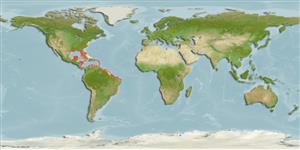Environment: milieu / climate zone / depth range / distribution range
Écologie
marin récifal; profondeur 30 - 70 m (Ref. 13608). Subtropical; 43°N - 33°S, 98°W - 34°W
Western Atlantic: Massachusetts, USA and Bermuda through the Gulf of Mexico to Brazil. Most abundant member of the genus Haemulon along the eastern coast of Florida (Ref. 26938).
Length at first maturity / Taille / Poids / Âge
Maturity: Lm 14.0 range ? - ? cm
Max length : 28.0 cm TL mâle / non sexé; (Ref. 11824); common length : 18.0 cm TL mâle / non sexé; (Ref. 5217); poids max. publié: 85.60 g (Ref. 118626)
Épines dorsales (Total): 13; Rayons mous dorsaux (Total): 15; Épines anales 3; Rayons mous anaux: 9. Silvery white with a mid-lateral yellow stripe running from eye to a large round black spot at base of caudal fin; a second narrower yellow stripe on back above lateral line (Ref. 13442).
Maximum depth from Ref. 126840. Inhabits seagrass beds, sand flats, and patch reefs (Ref. 9710). Forms schools (Ref. 5521). Feeds on small crustaceans, mollusks, other benthic invertebrates, plankton, and algae (Ref. 3798). Marketed fresh and salted (Ref. 3798).
Oviparous, distinct pairing during breeding (Ref. 205).
Robins, C.R. and G.C. Ray, 1986. A field guide to Atlantic coast fishes of North America. Houghton Mifflin Company, Boston, U.S.A. 354 p. (Ref. 7251)
Statut dans la liste rouge de l'IUCN (Ref. 130435)
Menace pour l'homme
Reports of ciguatera poisoning (Ref. 30303)
Utilisations par l'homme
Pêcheries: intérêt commercial mineur; Aquarium: Aquariums publics; appât: usually
Plus d'informations
RéférencesAquacultureProfil d'aquacultureSouchesGénétiqueElectrophoresesHéritabilitéPathologiesTraitementNutrientsMass conversion
Outils
Articles particuliers
Télécharger en XML
Sources Internet
Estimates based on models
Preferred temperature (Ref.
123201): 23.3 - 28.1, mean 27.2 °C (based on 912 cells).
Phylogenetic diversity index (Ref.
82804): PD
50 = 0.5000 [Uniqueness, from 0.5 = low to 2.0 = high].
Bayesian length-weight: a=0.01479 (0.01247 - 0.01755), b=2.99 (2.95 - 3.03), in cm total length, based on LWR estimates for this species (Ref.
93245).
Niveau trophique (Ref.
69278): 4.4 ±0.0 se; based on diet studies.
Résilience (Ref.
120179): Milieu, temps minimum de doublement de population : 1,4 à 4,4 années (K=0.18-0.35; tmax=9; Fec=29,000).
Fishing Vulnerability (Ref.
59153): Moderate vulnerability (38 of 100).
Nutrients (Ref.
124155): Calcium = 29.1 [9.4, 83.4] mg/100g; Iron = 0.535 [0.250, 1.070] mg/100g; Protein = 20.2 [18.3, 22.1] %; Omega3 = 0.229 [0.108, 0.441] g/100g; Selenium = 10.6 [4.7, 23.9] μg/100g; VitaminA = 92.8 [28.4, 309.6] μg/100g; Zinc = 0.773 [0.465, 1.274] mg/100g (wet weight);
